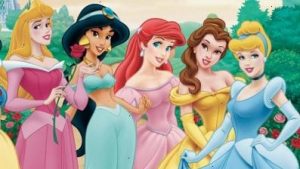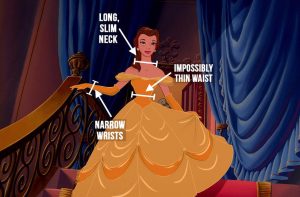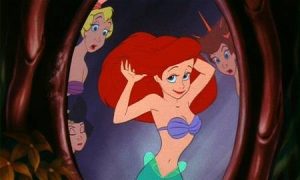
In this photo, small waistlines and unrealistic body types are represented in multiple of the Disney Princesses. http://wikdpedia.wikispaces.com/file/view/disney_princesses.jpg/222136506/disney_princesses.jpg
The more troubling depictions of women is the way in which young girls are taught that their “most valuable asset is [their] beauty” (Hains). This is known as the feminine beauty ideal and is pervasive throughout the princess movies. Most likely unintentionally, Disney has objectified and devalued women and body types since their first film in 1937. Through a statistical analysis of the movies, this criticism is quite evident. 94% of the fairy tale and princess movies mention physical appearance. Within each movie, this discussion occurs on average 13.6 times, with a range from 0 to 114 times for female physical appearance and a range from 0 to 35 times for male physical appearance. The sheer difference in number of times physical attraction is discussed based on gender is an explicit representation of the polarity and inequality represented in these films.

Here, Belle’s body is measured in order to represent her unfathomably small size. https://img.buzzfeed.com/buzzfeed-static/static/2015-06/26/10/enhanced/webdr14/edit-wide-23390-1435327406-2.jpg
It is also important to understand the relation of physical beauty to character and other qualities within these stories. In 31% of the stories, beauty and goodness are associated with one another — most often referring to the princess as being chaste and innocent. Similarly, ugliness and evil are related in 17% of the princess stories. For example, Snow White’s stepmother is seen as “intelligent, independent, and is sure of what she wants” (Disney princesses). However, she is ridiculed and labeled as the antagonist, while Snow white is compliant and naive. While any form of physical appearance and personality association is detrimental to a girl’s self-esteem, this stark separation between beauty and ugliness, goodness and evil is extremely harmful. Throughout the majority of the films, the antagonist is depicted as less attractive than the protagonist, representing her as the old, ugly witch. This is exhibited repeatedly, from Cinderella, to Snow White to The Little Mermaid. Bestowing these positive personality attributes, such as intelligence and independence, onto the unattractive, antagonistic character leads young girls to want to associate with the personality attributes of the beautiful princess.
The most upsetting issue surrounding the depiction of these women and their physical appearance is the unrealistic portrayal of body image within the fairy tales. As seen in the images above, every princess has an unnaturally small waist, large breasts, fair skin, exaggerated eyes and batting eyelashes. Buzzfeed wrote an article in which members of the team dressed up in costume as a Disney Princess and had their bodies digitally altered to fit the frame that is represented in the animations. They clearly are able to reveal the unrealistic, and harmful, alterations that Walt Disney has created. Similarly, another website, Above Average, found that in 6 out of the 11 Disney Princesses, their eyes were larger than their waists. This displays the lack of credible anatomical basis within the creation of these characters. While the actual relation between the size of their waists and breasts is physically impossible, their innocent yet sexualized facial features suggest a storyline beyond a pure, childlike storyline as well. These implausible bodies are representations of the “ideal feminine body-subject” in which women are taught to be “smaller than a man, demure, and take up little space” (Giovanelli). This is clearly illustrated in these movies both in the body type of the women and the large, masculine bodies of the princes.

Another Princess, Ariel, is displayed here in both a sexual pose, lacking clothing which allows the audience to examine her body even more accessibly. http://images2.fanpop.com/image/polls/320000/320990_1257063812489_full.jpg?v=1257063879
Although these depictions of women are offensive and degrading, some could argue it is because the Disney Princesses emerged at a point when conventional gender roles were at an unnatural height in society and media. The period following World War II was a time of heightened domestic idealism in the United States. It is not surprising, therefore, that the conservative gender ideals found in Disney princess films were readily embraced by audiences. However, this does not excuse the artists’ and producers’ choices and definitely does not justify Disney’s continuing depiction of passive and physically impossible female characters in their current adaptations; for example, consider the size of Cinderella’s waist in the 2016 adaptation.
Finally, there is evident pushback within society against the depiction of females in the princess movies as unrealistic and overly sexualized. A blogger took it upon herself to create the “curvy version” of the princes in an article “If Disney Princesses Were Curvy Kate Girls…” While I admire the attempt at representing the princesses as more accessible to female viewers, some of them such as Snow White and Pocahontas are hardly “curvy” and promote a false idea of what a bigger figure might look like.
Emma Hatheway